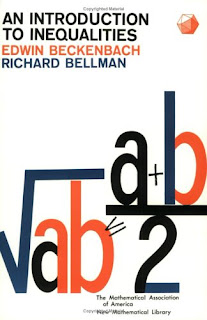Book title: An Introduction to Inequalities.
Authors: Edwin Beckenbach, Richard Bellman.
Publisher: The L. W. Singer Company.
ISBN: 61-6228.
Preface
Mathematics has been called the science of tautology; that is to say, mathematicians have been accused of spending their time proving that things are equal to themselves. This statement (appropriately by a philosopher) is rather inaccurate on two counts. In the first place, mathematics, although the language of science, is not a science. Rather, it is a creative art. Secondly, the fundamental results of mathematics are often inequalities rather than equalities.
In the pages that follow, we have presented three aspects of the theory of inequalities. First, in Chapters 1, 2, and 3, we have the axiomatic aspect. Secondly, in Chapter 4, we use the products of the preceding chapters to derive the basic inequalities of analysis, results that are used over and over by the practicing mathematician. In Chapter 5, we show how to use these results to derive a number of interesting and important maximum and minimum properties of the elementary symmetric figures of geometry: the square, cube, equilateral triangle, and so on. Finally, in Chapter 6, some properties of distance are studied and some unusual distance functions are exhibited.
There is thus something for many tastes, material that may be read consecutively or separately. Some readers will want to understand the axiomatic approach that is basic to higher mathematics. They will enjoy the first three chapters. In addition, in Chapter 3 there are many illuminating graphs associated with inequalities. Other readers will prefer for the moment to take these results for granted and turn immediately to the more analytic results. They will find Chapter 4 to their taste. There will be some who are interested in the many ways in which the elementary inequalities can be used to solve problems that ordinarily are treated by means of calculus. Chapter 5 is intended for these. Readers interested in generalizing notions and results will enjoy the analysis of some strange non-Euclidean distances described in Chapter 6.
Those whose appetites have been whetted by the material presented here will want to read the classic work on the subject, Inequalities, by G. H. Hardy, J. E. Littlewood, and G. P6lya, Cambridge University Press, London, 1934. A more recent work containing different types of results is Inequalities, by E. F. Beckenbach and R. Bellman, Ergebnisse der Mathematik, Julius Springer Verlag, Berlin, 1961.






